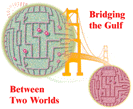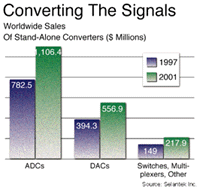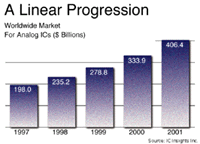
(11/05/1998)
Analog, Mixed-Signal ICs
Bridging The Gulf Between Two Worlds
Data converters are the link
between analog and digital technologies
John H. Mayer
 Despite
an undeserved perception that analog design is a quiet niche best left
to a small number of specialists, the analog-IC market is actually quite
healthy. Analysts at the market research firm IC Insights Inc.,
Scottsdale, Ariz., predict that the analog-IC market will increase from
$23.5 billion
this year to more than $40.6 billion in 2001.
Despite
an undeserved perception that analog design is a quiet niche best left
to a small number of specialists, the analog-IC market is actually quite
healthy. Analysts at the market research firm IC Insights Inc.,
Scottsdale, Ariz., predict that the analog-IC market will increase from
$23.5 billion
this year to more than $40.6 billion in 2001.
"Despite the tendency for designs to become more digitally oriented,
there's a continual need to interface to the analog world and for analog
chips," said Brian Matas, vice president of market research at IC Insights.
Matas said that every new market for digital devices also opens up opportunities
for analog devices. "We're pretty confident that the analog-IC market will
grow in the 15% to 17% range on average over the next five years," he said.
The links

The direction in which the analog and mixed-signal market is headed
is perhaps best represented by data converters. Bridging
the gulf between the analog and digital world, data converters represent
one of the largest, fastest-growing segments of today's market for analog
and mixed-signal ICs.
"By definition, the world out there is not digital, it's analog; so
to convert a signal into digital, you need a data converter," said Charles
Mantel, executive vice president and analyst at market research firm Selantek
Inc., Mountain View, Calif.
Analysts at IC Insights said data-converter shipments in 1997
reached $1.3 billion, and they expect shipments to grow to more than $2.2
billion by 2001. Leading vendors include Analog
Devices Inc.(ADI), Norwood, Mass.; Burr-Brown
Corp., Tucson, Ariz.; Philips
Semiconductors Inc., Sunnyvale, Calif.; and Texas
Instruments Inc. (TI), Dallas.
Prices for data converters vary considerably based on resolution and
speed. Lower-performance 6-bit and 8-bit parts can sell for less than $1,
while high-performance 16-bit devices can top $50.
Communications
Communications and video/image processing are two of the fastest-growing
applications for data converters. Speed continues to be the
dominant performance requirement for communications applications, particularly
in cable and wireless-signal-encoding equipment.
Parts such as ADI's
AD9281 and AD9201 ADCs, introduced last month, offer 8-bit and
10-bit resolution, respectively, and operate at 20 Msamples/s to support
a wide variety of narrowband and wideband applications. Similarly, ADI's
new AD9731 10-bit bipolar DAC meets the demanding performance characteristics
of cable modems, base stations, and other digital communications systems
by offering 170 Msamples/s and 10-bit resolution at a price point compatible
with high-volume commercial applications.
New 12-bit ADCs such as the TDA8767 and TDA8768 from Philips
offer sampling rates of up to 55 MHz. Optimized for telecommunications
applications such as base stations, the TDA8768 is designed to work with
the TDA9901, a new wideband differential, digitally controlled variable-gain
amplifier from Philips that has been optimized for fast switching between
different gain settings. The TDA8767 is avai lable in three versions with
10-, 20-, and 30-MHz sampling frequencies. The integrated bipolar chip
features differential or single analog input, improved noise reduction,
and enhanced resolution with a differential nonlinearity of +/-0.6 least
significant bit, according to the company. Philips executives said that
in the near future, the company will add parts that offer 14-bit conversion.
Maxim Integrated Products Inc.,
Sunnyvale, is targeting applications in IF sampling receivers, networks,
VSAT receivers, and even some high-performance instrumentation with its
new 6-bit ADC that combines a high sampling rate with low power. The MAX1011
offers a sampling rate of up to 90 Msamples/s, yet it dissipates just 210
milliwatts typical. The data converter features an internal reference and
a clock oscillator with overdrive capability. It operates off either a
5-V or 3.3-V supply, and is available in a 24-pin QSOP.
Better images
Growth in the market for data converters isn't restricted to communications.
Two
of the fastest-growing segments for data converters are document imaging
- scanners, printers, and fax machines - and video, including motion-surveillance
cameras, machine vision, camcorders, and videoconferencing. Typically,
scanners and multifunction printers and faxes require input sampling rates
of up to 5 Msamples/s, while video equipment demands sampling rates in
the 10-Msample/s to 30-Msample/s range. Resolutions range from 8 bits to
12 bits.
"If you're digitizing data from an image sensor, some performance characteristics,
such as signal-to-noise ratio, are critical, while others, such as distortion,
are not as important," said Roger Levinson, director of engineering at
the video and imaging division of Exar
Corp., Fremont, Calif. "In video, however, if you're going to be digitizing
NTSC, PAL, or any of the other analog standards, differential phase
and
differential gain become critical," he said. "Exar has recently introduced
a number of high-performance ADCs to meet the requi rements for markets
such as these." The company's 10-bit XRD6440 ADC, for example, uses
a parallel successive-approximation register architecture that interleaves
16 10-bit ADCs to achieve 40 Msamples/s. An on-chip auto-calibration
circuit continuously adjusts the offset and linearity to maintain accurate
operation over time and temperature and to support the performance requirements
of medical ultrasound devices, I and Q modems, machine-vision systems,
and high-end digital cameras. For 12-bit applications, Exar is offering
the XRD6622 ADC. The part offers a 20-Msample/s sampling rate, an
on-chip reference, and internal sample and hold. The XRD6622 has a new
pipeline
converter architecture that uses a six-stage serial conversion technique
to deliver better dynamic performance, according to Levinson.
Relentless consumer demand for better image quality, which translates
into better shading on individual pixels, is driving various markets to
higher resolutions, he said. "We came out with 10-bit and 12-b it parts
to meet different market demands," Levinson said. "In the video and imaging
marketplace, for example, video camcorders are for the most part 10-bit;
but as you move into digital-still cameras and scanners, the equipment
is all moving to 12-bit."
Other higher-performance ADCs are helping designers commercialize high-end
applications in professional video and HDTV by eliminating the costs of
hybrids or modules.
 Signal
Processing Technologies Inc., Colorado Springs, Colo., uses a two-stage
subranging architecture in its SPT7871 and SPT7870, which deliver 10-bit
performance with sample rates of 100 Msamples/s. Digital error-correction
logic combines the results of both stages to produce the 10-bit digital
output. The SPT7871 supports TTL outputs, while the SPT7870
supports ECL and PECL outputs. The ICs each sell for $50 in 1,000s.
Signal
Processing Technologies Inc., Colorado Springs, Colo., uses a two-stage
subranging architecture in its SPT7871 and SPT7870, which deliver 10-bit
performance with sample rates of 100 Msamples/s. Digital error-correction
logic combines the results of both stages to produce the 10-bit digital
output. The SPT7871 supports TTL outputs, while the SPT7870
supports ECL and PECL outputs. The ICs each sell for $50 in 1,000s.
Powering down
The burgeoning market for battery-powered cell phones and portable instruments
has also opened up opportunities for vendors offering data converters that
dissipate little power and come in compact packages.
Burr-Brown is sampling a 12-bit
ADC that dissipates 11 mW typical at a 500-kHz throughput rate. A power-down
mode drops dissipation to just 2.5 mW. The ADS7818 is available
in an 8-pin plastic mini-DIP or an 8-lead MSOP.
 The demand
for data converters that can operate off lower voltages is growing rapidly.
Market
researchers at Selantek estimate that 27% of all stand-alone data converters
shipped in 1996 were low-voltage devices. By 2000, that number is expected
to jump to 60%. But building higher-performance data converters that can
operate off low voltage remains a significant design challenge.
The demand
for data converters that can operate off lower voltages is growing rapidly.
Market
researchers at Selantek estimate that 27% of all stand-alone data converters
shipped in 1996 were low-voltage devices. By 2000, that number is expected
to jump to 60%. But building higher-performance data converters that can
operate off low voltage remains a significant design challenge.
Most of today's 10-bit and 12-bit high-performance devices run off a
5-V supply. "At 10-bit, you can find some products at a 20-MHz sampling
rate and below that operate at 3 V," Exar's
Levinson said. "But when you ge t to 12-bit performance, it becomes very
tough because many of the standard ways for implementing CMOS at low cost
make it difficult to build a low-voltage, high-performance device."
Smaller packaging
Small footprint is also critical in the portable-electronics arena.
Analog
Devices, for example, has managed to squeeze its new AD5300
family of DACs into tiny SO-23 packages to offer up to a 40% smaller footprint
than comparable competing devices. The 8-, 10-, and 12-bit DACs feature
single-voltage outputs and 100-microamp current consumption. All three
devices operate from a single +2.7-V to +5.5-V supply and consume 0.4 mW
at 3 V. A separate power-down function cuts typical current consumption
to 20 nanoamps at 3 V by internally switching the output to a resistor
network of known values. Prices range from $1.50 to $2.50 in 1,000s.
Portable-systems designers who want to upgrade to 10-bit resolution
can turn to DACs such as the LTC1660 introduced last month by Linear
Technology Corp., Milpit as, Calif. The micro-power octal 10-bit device
packs eight rail-to-rail voltage-output DACs into a narrow 16-pin SSOP.
The LTC1660 operates from a single 3-V or 5-V supply and typically consumes
only 450 microamps of current. In sleep mode, the current drops to 1 microamps
. Prices for the DAC begin at $5.35 in quantities of 1,000 or higher.
Industrial process and motor control represent other growth opportunities
for data-converter suppliers. Typical motor-control circuits feature a
microprocessor, digital logic, power discretes, and a DAC.
 Products
such as
Burr-Brown's DAC7614
combine small size with low power requirements for control, data acquisition,
or closed-loop servo-control applications. The 12-bit, serial input, quad,
voltage-output DAC dissipates 20 mW while offering guaranteed 12-bit monotonic
performance over its -40 degrees C to +85 degrees C operating temperature
range.
Products
such as
Burr-Brown's DAC7614
combine small size with low power requirements for control, data acquisition,
or closed-loop servo-control applications. The 12-bit, serial input, quad,
voltage-output DAC dissipates 20 mW while offering guaranteed 12-bit monotonic
performance over its -40 degrees C to +85 degrees C operating temperature
range.
As they already have in many markets, lower-cost DSPs are expected to
catch fire in the motor-control market and, in the process, build demand
for data converters.
"Declining DSP signal processing costs have been great for the data-converter
business," said Eric Swanson, chief technology officer at Cirrus
Logic Inc., Fremont, a manufacturer of high-performance data converters.
On-chip integration
While stand-alone data converters still dominate designs, the
drive toward system-on-a-chip methodology promises to eventually have a
significant impact on the market. Today, most on-chip
data-converter functions are limited to 8 bits of resolution and 5 MHz
of bandwidth. But analysts expect those performance restrictions
to diminish as semiconductor manufacturers migrate to finer-geometry processes.
Whether a converter is integrated into an ASIC is a complex decision.
"There's a reasonable amount of manufacturing and development overhead
whenever one integrates analog and mixed-signal functions in a large digital
environment, so the choices o f where and how to do that are being done
fairly carefully," Exar's
Levinson said. Performance plays a major role in the decision. While integrating
a slow 8-bit ADC is relatively commonplace, trying to place a 20-MHz, 12-bit,
high-performance ADC on the same substrate as hundreds of thousands of
digital gates remains a formidable challenge.
"If you want ultimate performance in analog, there are applications
where you don't want a couple of hundred thousand uncontrolled digital
transistors on the same die chattering away and giving you crosstalk,"
Cirrus
Logic's Swanson said. "While you can always get as much isolation as
you want between the digital and the analog domain, you can really lose
time to market tracing down some of those gremlins." The problem, according
to analog designers, lies in a paucity of design tools. "You can't really
simulate global coupling of digital-domain phenomena into analog on the
same chip," Swanson said. "There's no tools that allow you to do that,
and I'm not sure the tools will ever get there."
John H. Mayer is a freelance technical writer based in Belmont, Mass.
Copyright © 1998 CMP Media Inc

 Despite
an undeserved perception that analog design is a quiet niche best left
to a small number of specialists, the analog-IC market is actually quite
healthy. Analysts at the market research firm IC Insights Inc.,
Scottsdale, Ariz., predict that the analog-IC market will increase from
$23.5 billion
this year to more than $40.6 billion in 2001.
Despite
an undeserved perception that analog design is a quiet niche best left
to a small number of specialists, the analog-IC market is actually quite
healthy. Analysts at the market research firm IC Insights Inc.,
Scottsdale, Ariz., predict that the analog-IC market will increase from
$23.5 billion
this year to more than $40.6 billion in 2001.


 The demand
for data converters that can operate off lower voltages is growing rapidly.
Market
researchers at Selantek estimate that 27% of all stand-alone data converters
shipped in 1996 were low-voltage devices. By 2000, that number is expected
to jump to 60%. But building higher-performance data converters that can
operate off low voltage remains a significant design challenge.
The demand
for data converters that can operate off lower voltages is growing rapidly.
Market
researchers at Selantek estimate that 27% of all stand-alone data converters
shipped in 1996 were low-voltage devices. By 2000, that number is expected
to jump to 60%. But building higher-performance data converters that can
operate off low voltage remains a significant design challenge.
 Products
such as
Products
such as